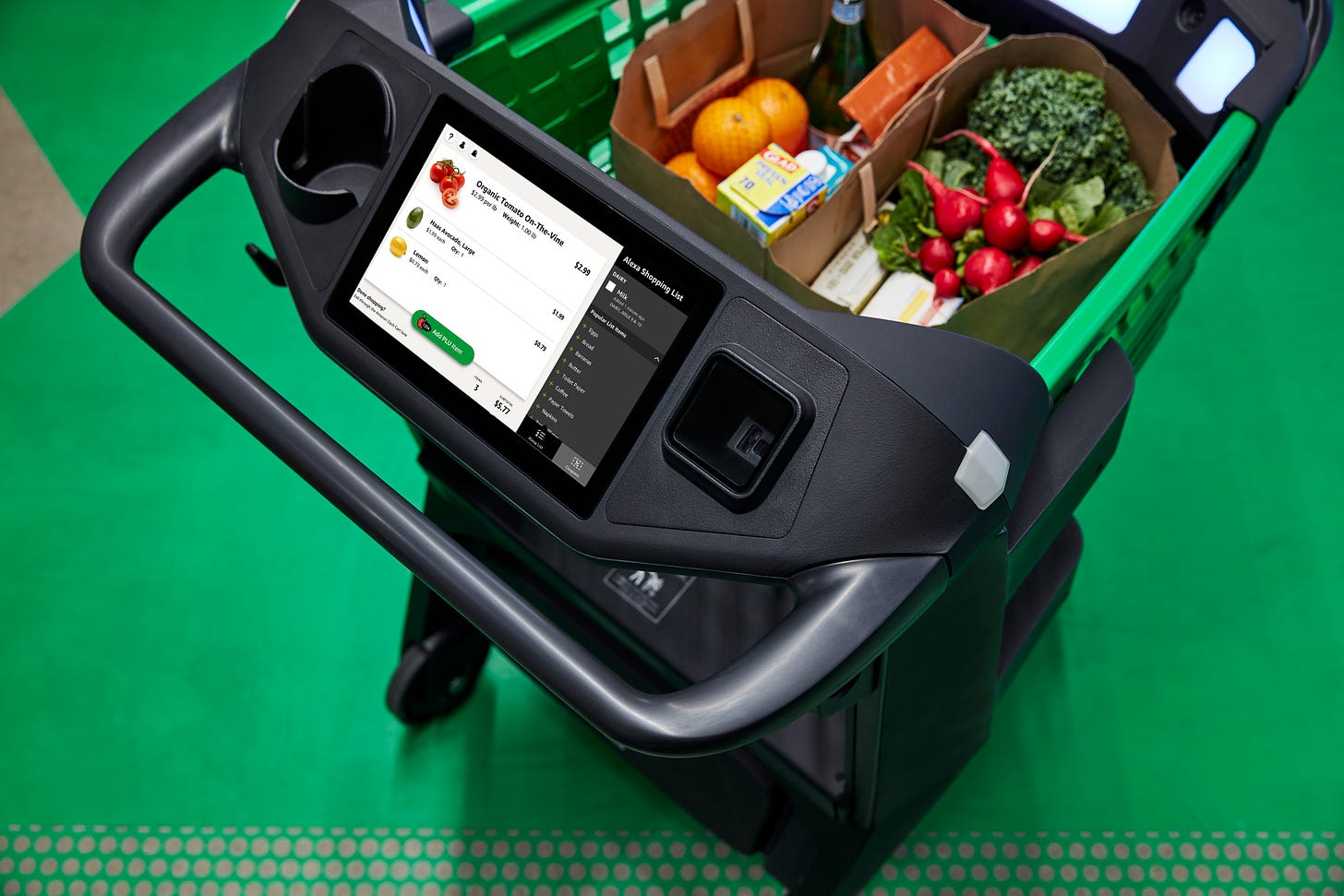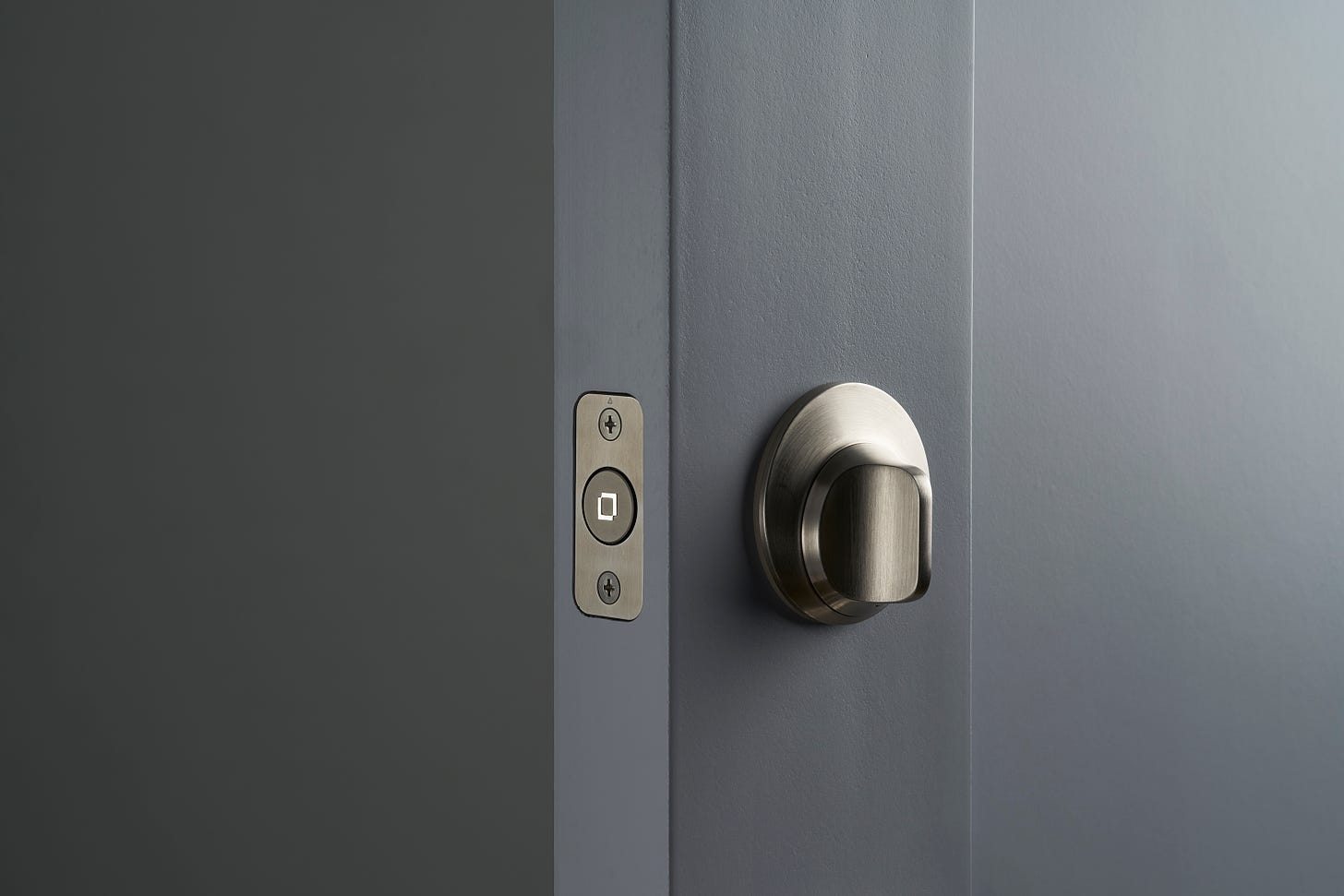Surface Texture - Issue 35
🦾 Musk’s brain-computer interface | 🛒 Bezos’ smart cart | 🗝 Dignified home security
Welcome to Surface Texture, the weekly newsletter covering product design trends and innovations for hardware designers, engineers, strategists, and entrepreneurs.
If you’re a new reader, you can read more about Surface Texture here! In a nutshell, we parse the hardware releases of the past week and deliver the top three product launches and why they matter to your inbox every Tuesday. Check out the archive to catch up on past issues of ST.
The products of Surface Texture, Issue 35:
🦾 Elon Musk’s venture to create a digital interface with the brain provided a progress update last Friday, sharing V2 of their Neurosurgical Robot
🛒 Amazon released their first Dash Carts into the wild, allowing customers to skip the check-out line
🗝 Level announced the Level Touch, a thoughtfully designed line of smart locks and door hardware
Neuralink Neurosurgical Robot
If you hadn’t already heard, last Friday, Elon Musk and Neuralink held a special event to announce their progress on developing a brain-machine interface, including unveiling version two of the surgical robot designed to “install” it. There’s been a ton of discussion online since the press event, including accusations of being “neuroscience theater,” but the best write-up so far can be found here. In a sentence, Neuralink is trying to create a method of reading and writing information directly to the brain through a small chip surgically placed beneath the skull… or as Musk explained:
“In a lot of ways, it’s kind of like a Fitbit in your skull, with tiny wires.”
On to the robot, designed in partnership with Woke Studios:


The robot, as most advanced medical equipment could be described these days, is consistent with the form language of the medical imaging industry — smooth, white, with neutral color breaks designating pinch points and working areas. With all the skepticism surrounding the feasibility of such a project, the robot appears very far along developmentally — past Neuralink projects have been notably conceptual, but this is very real (Friday’s product demo showcased a few pigs with sensors surgically placed by this robot). What’s interesting aesthetically is the completeness of the industrial design — it sells an image of conceptual readiness, while conveying a feeling of safety to potential future customers.

If you’re inventing a new process to connect people’s brains to computers, there’s a lot of work to do in convincing those people that the procedure — removing a part of your skull and accupunctur-ing your brain with electrodes — is both safe and a reasonable thing to do. It’s a radical idea (!) and will take time to shift cultural responses to the prospect. The industrial design of Neuralink’s surgical robot needed to be refined enough to convince the public that it’s possible — its like the opposite of a concept car, it has to be production-intent and use a form language consistent with medical products in order to be convincing enough that the vision could be a reality.

There’s a lot more we could talk about — from the implications on UI/UX (e.g. “your password must contain at least one emotion”) to proprioception — please leave a comment if you want to be a part of the conversation 😁
Amazon Dash Cart
This week, Amazon announced the Dash Cart as part of the technological expansion of their Amazon grocery stores, starting with their Woodland Hill location in LA. The new store is an alternative take to the vision-based Amazon Go stores that made headlines in the past three years, offloading the object recognition to the Dash Cart through integrated weight sensors rather than hundreds of cameras.


The Dash Cart workflow simply adds the self-checkout aisle to your cart: scan a QR code in the Amazon app to ID yourself, scan items before placing them in your cart, then leave the store. Items like fresh produce are pulled up on the integrated tablet when adding to the cart — the “basket” of the cart floats in contact with a weight sensor to determine the price of these items. Unfortunately, it appears the “unexpected item in the cart area” dance remains as a means of theft deterrent (lighting inside the cart changes orange/red when an un-scanned item is placed in the cart). The carts are only intended for small to medium-sized grocery runs, as they can only accommodate two paper bags at a time.

We wonder if the Dash Cart is a response to heightened privacy awareness — it’s kind of eerie being watched by so many cameras in the Amazon Go stores, and customers may be more attuned and more sensitive to being monitored in 2020 (Walmart is a little more in-your-face about watching you). Although, it can’t be cheap to outfit a store with a bunch of cameras… perhaps this is just a cost reduction strategy. By implementing self-checkout technology that customers are well-accustomed to on the cart, you can achieve Amazon Go performance with much less machine vision complexity.
Side-note: it’s fun comparing the Dash Cart to IDEO’s re-imagined shopping cart from 1999.
Level Touch Smart Locks
Level’s new “Touch” line of smart locks takes a refreshing approach to security by showing restraint in externalizing it’s “smart home” features. All too often, we see “smart” products bragging about how “smart” they are. In the home security world, its often with gummy keypads or a piercing blue LED. Level internalizes all of these smarts by keeping the motorized locking mechanism and associated sensors inside the frame of the door. The result is a product that falls away in every day use by letting a door be a door.


The Touch lock gets its namesake by unlocking when an authorized user touches the lock when in possession of a smartphone or key card. Level forgoes any additional branding when facing the door, instead, adding a discrete logo to the front face of the lock cylinder.


We hinted at the potential subtle nature of “smart” products in the Solgaard Home Base, but Level does an excellent job of letting technology tack a backseat to our already tech-heavy lives.
PS — A few notes this week:
🎙 We’re live on Twitter! You can follow Surface Texture here. A lot of material barely misses making the newsletter every week — this is a good place to find it.
🔍 If you’re having trouble seeing this email (Outlook loves messing with buttons and formatting), try checking out Surface Texture online or sign up with another email. Alternatively, following ST on Twitter will keep you in the loop.
If you like what you read, please subscribe and share! In the meantime, you can catch up on old issues here.
Are you launching a new hardware product in the near future? Submit a link for consideration for a future issue.


